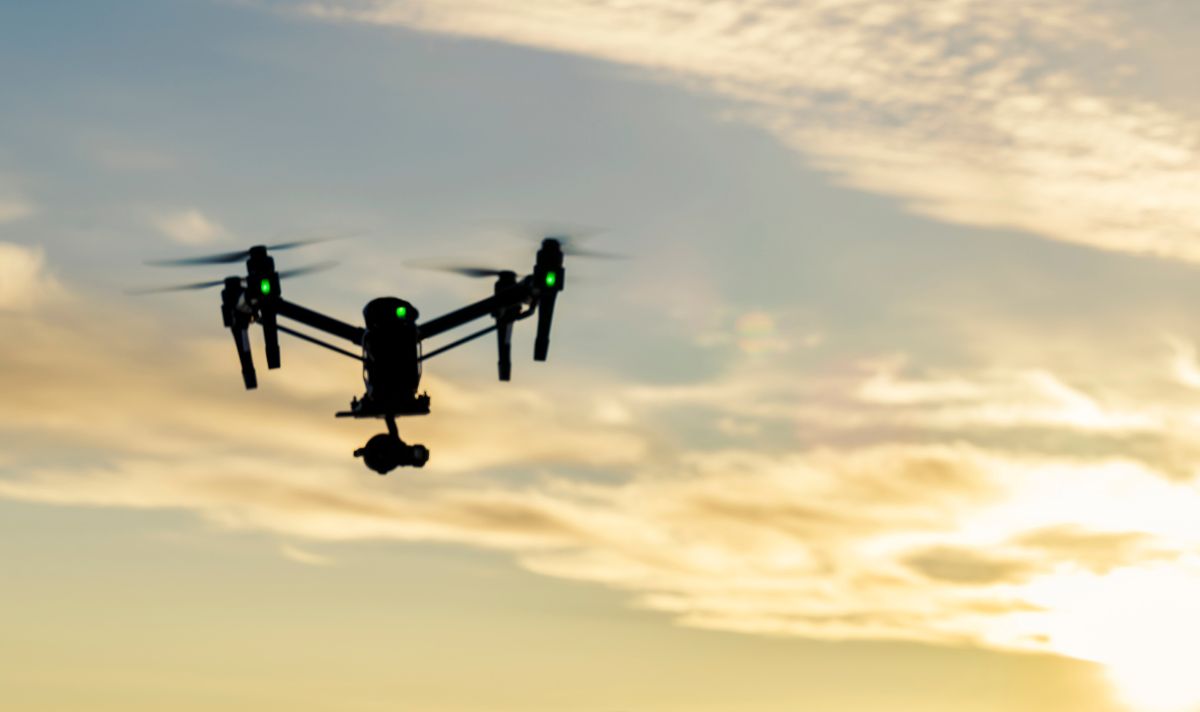Drone News Today: Dive into the buzzing world of unmanned aerial vehicles! This week’s headlines are filled with exciting advancements, concerning accidents, and crucial regulatory shifts shaping the future of drone technology. We’ll explore everything from cutting-edge AI integration and innovative commercial applications to the ethical dilemmas and legal challenges that define this rapidly evolving field. Get ready for a comprehensive overview of what’s making waves in the drone industry.
From life-saving search and rescue missions to groundbreaking advancements in agriculture and delivery systems, drones are transforming numerous sectors. We’ll examine the economic impact, both positive and negative, alongside the public perception and ongoing debates surrounding privacy and safety. This report provides a balanced perspective on the current state of drone technology and its implications for society.
Drone news today is buzzing with exciting developments, from new models to innovative applications. But even the best drones can have problems, which is why knowing where to go for repairs is crucial. If you’re a DJI owner facing a malfunction, check out this great resource for dji drone repair to get your bird back in the air quickly.
Staying informed on drone news today means keeping your equipment in top shape, too!
Recent Drone Accidents and Incidents
The past week has seen a concerning rise in drone-related incidents, highlighting the ongoing need for robust safety regulations and pilot training. This section details three significant accidents, compares international regulations, proposes a safety protocol, and analyzes the economic impact of a major incident.
Drone news today is buzzing! A big story involves advancements in military drone technology, specifically focusing on the capabilities of the predator drone , and how those improvements are shaping future conflicts. This development is definitely a major talking point in the current drone news cycle, influencing discussions on both military strategy and civilian airspace safety.
Three Recent Drone Accidents
Three notable drone accidents occurred recently. In rural France, a drone malfunction caused by a faulty battery resulted in a collision with a power line, causing a brief power outage affecting several hundred homes. In California, a drone carrying a hazardous materials payload crashed due to operator error, leading to a temporary evacuation of the surrounding area. Finally, in a densely populated area of Tokyo, a collision between two drones resulted in minor property damage and a disruption of air traffic for a short period.
These incidents underscore the potential risks associated with drone operation.
Comparison of Drone Safety Regulations
The United States and the United Kingdom exhibit contrasting approaches to drone regulation. The US Federal Aviation Administration (FAA) employs a tiered system of licensing and airspace restrictions, emphasizing a risk-based approach. The UK’s Civil Aviation Authority (CAA) focuses on a more comprehensive registration system and emphasizes operator competence. While both aim for safety, their approaches differ in granularity and enforcement mechanisms.
Hypothetical Safety Protocol for Mid-Air Collisions
To mitigate mid-air collisions, a proposed safety protocol incorporates mandatory ADS-B (Automatic Dependent Surveillance-Broadcast) integration in all commercial drones, coupled with a sophisticated traffic management system using real-time data analysis and collision avoidance algorithms. This system would alert pilots to potential conflicts and autonomously maneuver drones to prevent collisions. Regular system updates and rigorous testing would be crucial.
Economic Impact of a Major Drone Accident, Drone news today

A major drone accident, such as a collision with an aircraft at a busy airport, could have devastating economic consequences. The cost would include damages to property, disruption of air travel (resulting in lost revenue for airlines and related businesses), legal fees, and potential loss of life leading to further compensation claims. The insurance industry would also face significant losses, potentially affecting premiums for drone operators.
Drone Technology Advancements
The drone industry is experiencing rapid technological advancements, leading to increased autonomy, enhanced capabilities, and expanded applications. This section explores the latest features of leading commercial drones, the role of AI, emerging technologies, and the ethical implications of these advancements.
New Features in Leading Commercial Drone Models
Three leading commercial drone models showcase significant improvements. DJI’s Matrice 300 RTK boasts extended flight time, advanced obstacle avoidance, and improved thermal imaging capabilities. Autel Robotics’ EVO Nano+ offers a compact design with impressive image quality and intelligent flight modes. Skydio’s X2 offers autonomous flight and object tracking, enabling complex maneuvers with minimal operator intervention. These advancements enhance operational efficiency and data acquisition.
AI’s Impact on Drone Autonomy and Functionality
Artificial intelligence is revolutionizing drone capabilities. AI-powered object recognition enables drones to autonomously identify and track targets, improving precision in tasks like agriculture and infrastructure inspection. AI-driven flight planning optimizes routes and avoids obstacles, increasing efficiency and safety. AI also plays a critical role in processing and analyzing the vast amounts of data collected by drones.
Emerging Drone Technologies
Three emerging drone technologies hold significant promise. Drone swarms offer the potential for coordinated operations in diverse fields like search and rescue, environmental monitoring, and precision agriculture. Long-range drones with extended flight times are opening up new possibilities for logistics and infrastructure monitoring. Hybrid drone designs, combining electric and fuel-powered propulsion, offer extended range and payload capacity, suitable for demanding missions.
Ethical Implications of Advanced Drone Technologies
The development of autonomous weapons systems (AWS) raises significant ethical concerns. The potential for unintended consequences, lack of human oversight, and the dehumanization of warfare demand careful consideration. International regulations and ethical guidelines are crucial to prevent misuse and ensure responsible development.
Drone Use in Various Industries
Drones are transforming various sectors, offering unique advantages in diverse applications. This section provides a comparative analysis of drone usage in agriculture, construction, and filmmaking, examines leading delivery companies, and highlights their contributions to search and rescue and environmental monitoring.
Drone news today is buzzing! A big part of that is the ongoing discussion surrounding military applications, and you’ll often find predator drone technology featured prominently. Understanding these advancements is key to following the latest developments in the world of drone technology, so keep an eye out for more updates on the news.
Drone Applications Across Industries
| Industry | Advantages | Disadvantages | Applications |
|---|---|---|---|
| Agriculture | Precision spraying, crop monitoring, efficient surveying | High initial investment, weather dependency, regulatory hurdles | Crop health assessment, targeted pesticide application, land surveying |
| Construction | Site surveying, progress monitoring, safety inspections | Weather limitations, potential for data loss, operator skill requirements | 3D modeling, progress tracking, structural inspections |
| Filmmaking | Unique perspectives, cost-effective aerial shots, maneuverability | Licensing restrictions, potential for accidents, weather sensitivity | Aerial cinematography, dynamic camera movements, capturing stunning landscapes |
Top Drone Delivery Companies
Amazon, DHL, and UPS are leading the charge in drone delivery. Amazon’s Prime Air focuses on last-mile delivery to residential areas. DHL utilizes drones for efficient delivery in remote or challenging terrains. UPS’s Flight Forward program concentrates on healthcare and medical supplies delivery. Each company employs unique strategies based on their infrastructure and target markets.
Drones in Search and Rescue
Drones equipped with thermal imaging cameras are invaluable in search and rescue operations. They can quickly cover large areas, locate missing persons, and assess disaster zones, providing critical information to rescue teams. Their ability to navigate challenging terrain and operate in hazardous conditions makes them an essential tool.
Drones in Environmental Monitoring and Conservation

Drones are playing an increasingly important role in environmental monitoring and conservation. They are used to monitor deforestation, track endangered species, assess wildlife populations, and monitor pollution levels. High-resolution imagery and data analysis provide valuable insights into ecosystem health and support conservation efforts.
Legal and Regulatory Developments in Drone Usage
The legal landscape surrounding drone operation is constantly evolving, presenting challenges and opportunities. This section explores the legal framework in a specific country (the US), addresses the challenges of commercial drone regulation, compares privacy concerns, and discusses the implications of drone use in conflict zones.
US Drone Operation Legal Framework
In the US, the FAA regulates drone operation, requiring registration for most drones, pilot certification for commercial use, and adherence to airspace restrictions. These regulations aim to ensure safety and prevent unauthorized drone flights. The FAA’s Part 107 regulations govern commercial drone operations, setting forth detailed requirements for pilots and operations.
Challenges in Regulating Commercial Drone Use
Regulating commercial drone use presents several challenges. Keeping pace with technological advancements, ensuring consistent enforcement across diverse jurisdictions, and balancing safety with innovation are ongoing concerns. The increasing complexity of drone technology and applications requires adaptable and comprehensive regulatory frameworks.
Privacy Concerns Related to Drone Surveillance

Drone surveillance raises significant privacy concerns, particularly in urban environments where the potential for unauthorized monitoring is higher. Balancing the benefits of drone technology with the protection of individual privacy requires careful consideration of data collection, storage, and usage policies. Rural areas present different challenges, as the potential for intrusion is often less apparent but can have a disproportionate impact on smaller communities.
Drone Use in Conflict Zones and International Law
The use of drones in conflict zones raises complex legal and ethical questions concerning international humanitarian law and the laws of war. Issues surrounding accountability, proportionality, and the targeting of civilians need careful consideration. The increasing autonomy of drones further complicates these issues, demanding international cooperation to establish clear guidelines and regulations.
Economic Impact of Drones
The drone industry is poised for significant growth, creating both economic opportunities and challenges. This section examines projected market growth, job creation potential, benefits in supply chain management, and potential impediments to industry growth.
Projected Growth of the Global Drone Market
| Year | Market Size (USD Billion) | Agriculture | Delivery |
|---|---|---|---|
| 2023 | 30 | 5 | 8 |
| 2028 | 75 | 15 | 25 |
Note: These figures are hypothetical examples for illustrative purposes only. Actual market growth will vary based on numerous factors.
Job Creation Potential of the Drone Industry
The drone industry is creating jobs across various sectors, including manufacturing, software development, pilot training, data analysis, and maintenance. As drone technology expands, the demand for skilled professionals will continue to grow, creating significant employment opportunities.
Economic Benefits of Drone Integration in Supply Chain Management
Drones offer the potential to optimize supply chain management by providing faster and more efficient delivery, particularly for time-sensitive goods. Reduced transportation costs, improved inventory management, and enhanced delivery tracking are among the benefits. This can lead to significant cost savings and increased competitiveness.
Challenges to Economic Growth of the Drone Industry
Three key challenges to the drone industry’s economic growth include regulatory hurdles, technological limitations, and the need for skilled labor. Addressing these challenges is crucial for realizing the full economic potential of drone technology.
Public Perception and Social Impact of Drones: Drone News Today
Public perception of drones varies depending on context and individual experiences. This section explores public attitudes, potential for social inequality, positive social impacts, and common privacy concerns.
Public Perception of Drones
Public perception of drones is generally positive in rural areas, where they are often seen as beneficial for agriculture, surveillance, and search and rescue. However, in urban areas, concerns about privacy and safety are more prominent. This difference reflects the varied contexts of drone usage and its potential impact on different communities.
Potential for Drones to Exacerbate Social Inequalities
The unequal access to drone technology and its benefits could exacerbate existing social inequalities. Wealthier individuals and organizations may be better positioned to leverage drone technology for economic gain, potentially widening the gap between socioeconomic groups. Addressing this disparity requires equitable access and opportunities.
Positive Social Impacts of Drone Usage
Drones have made significant positive contributions in disaster relief efforts, delivering essential supplies and assessing damage in inaccessible areas. They have also been instrumental in wildlife conservation, environmental monitoring, and precision agriculture, contributing to sustainable development goals.
Common Concerns About Drone Privacy Implications
Common privacy concerns include unauthorized surveillance, data breaches, and the potential for misuse of drone-collected information. Establishing clear guidelines and regulations on data collection, storage, and usage is essential to mitigate these risks and build public trust.
Last Word
The drone industry is undeniably dynamic, a constant interplay of technological innovation, regulatory hurdles, and evolving societal acceptance. While challenges remain, particularly concerning safety regulations and ethical considerations surrounding autonomous systems, the potential benefits across various sectors are undeniable. Staying informed about Drone News Today is crucial for understanding the transformative power of this technology and its ongoing impact on our world.
Quick FAQs
What are the most common causes of drone accidents?
Pilot error, mechanical failure, and loss of signal are frequently cited causes. Weather conditions also play a significant role.
How much does a commercial drone typically cost?
Prices vary widely depending on features and capabilities, ranging from a few hundred dollars for basic models to tens of thousands for advanced professional drones.
What are the job prospects in the drone industry?
The industry offers diverse roles, including drone pilots, engineers, software developers, and technicians, with significant projected growth.
Are drones legal to fly everywhere?
No, drone regulations vary significantly by country and even by region within a country. Always check local laws before flying.
How can I get a drone pilot license?
Licensing requirements differ by location. Check with your national aviation authority for specific details and procedures.
